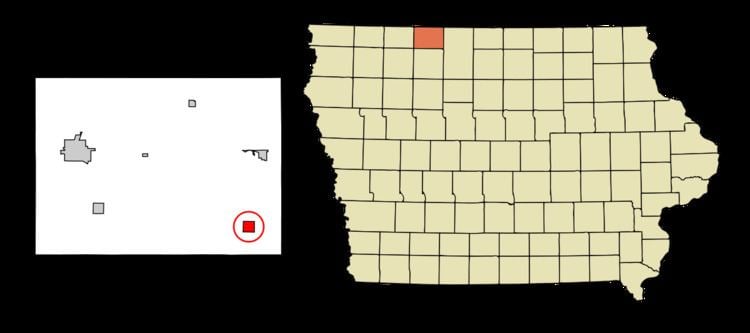FIPS code 19-67170 Area 2.8 km² Zip code 50578 Local time Thursday 8:05 AM | Time zone Central (CST) (UTC-6) GNIS feature ID 0460640 Elevation 391 m Population 409 (2013) Area code 712 | |
 | ||
Weather 3°C, Wind NE at 27 km/h, 99% Humidity | ||
Ringsted is a city in Emmet County, Iowa, United States. The population was 422 at the 2010 census.
Contents
Map of Ringsted, IA 50578, USA
History
Ringsted was platted in 1899. It was named after Ringsted, Denmark, the native home of an early settler.
Geography
Ringsted is located at 43°17′42″N 94°30′32″W (43.294961, -94.509027).
According to the United States Census Bureau, the city has a total area of 1.08 square miles (2.80 km2), all of it land.
2010 census
As of the census of 2010, there were 422 people, 193 households, and 113 families residing in the city. The population density was 390.7 inhabitants per square mile (150.9/km2). There were 221 housing units at an average density of 204.6 per square mile (79.0/km2). The racial makeup of the city was 97.6% White, 0.7% Native American, 0.9% from other races, and 0.7% from two or more races. Hispanic or Latino of any race were 1.4% of the population.
There were 193 households of which 24.9% had children under the age of 18 living with them, 46.1% were married couples living together, 9.8% had a female householder with no husband present, 2.6% had a male householder with no wife present, and 41.5% were non-families. 36.8% of all households were made up of individuals and 17.6% had someone living alone who was 65 years of age or older. The average household size was 2.19 and the average family size was 2.86.
The median age in the city was 43.3 years. 23.7% of residents were under the age of 18; 5.4% were between the ages of 18 and 24; 23.3% were from 25 to 44; 27.7% were from 45 to 64; and 20.1% were 65 years of age or older. The gender makeup of the city was 46.4% male and 53.6% female.
2000 census
As of the census of 2000, there were 436 people, 208 households, and 120 families residing in the city. The population density was 404.4 people per square mile (155.9/km²). There were 235 housing units at an average density of 218.0 per square mile (84.0/km²). The racial makeup of the city was 99.31% White, 0.23% Asian, and 0.46% from two or more races.
There were 208 households out of which 23.1% had children under the age of 18 living with them, 45.2% were married couples living together, 9.6% had a female householder with no husband present, and 42.3% were non-families. 40.9% of all households were made up of individuals and 23.1% had someone living alone who was 65 years of age or older. The average household size was 2.10 and the average family size was 2.82.
In the city, the population was spread out with 21.6% under the age of 18, 8.0% from 18 to 24, 21.8% from 25 to 44, 23.4% from 45 to 64, and 25.2% who were 65 years of age or older. The median age was 44 years. For every 100 females there were 97.3 males. For every 100 females age 18 and over, there were 94.3 males.
The median income for a household in the city was $24,286, and the median income for a family was $36,875. Males had a median income of $23,958 versus $17,250 for females. The per capita income for the city was $16,375. About 7.3% of families and 7.1% of the population were below the poverty line, including 11.4% of those under age 18 and 1.8% of those age 65 or over.
Danish-Lutherans
The city is known for its Danish-American and Lutheran population. The St. Ansgar Danish Lutheran Church was organized by the city's original founders in 1882. In 1894, due to a theological debate about the word of God and activities such as dancing, the Danish Lutheran community was divided into two groups nicknamed "Happy Danes" and "Sad Danes". A folk dance trope called "The Happy Dancing Danes" gained local popularity in the 1940s, given this name because "Happy Danes" did not believe dancing was sinful. The congregations were reunited in 2007.
